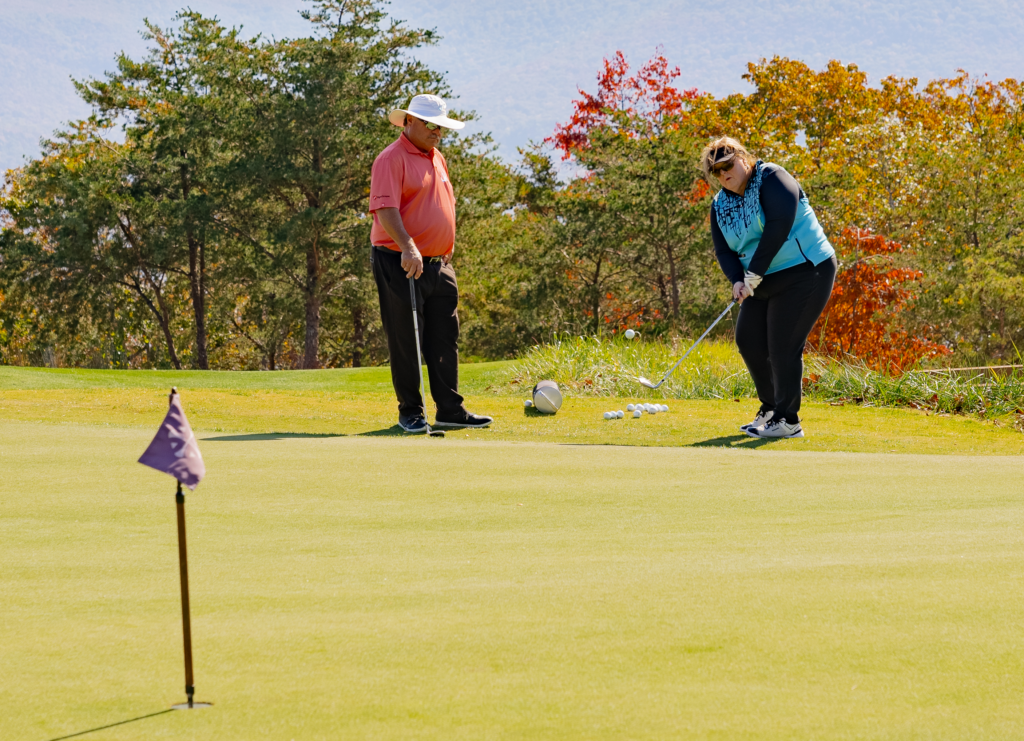Breaking 100 in golf is a significant milestone for many golfers. It’s a benchmark that signifies a leap from a beginner to a more competent and confident player. While you may be focusing your time and effort on improving your driving. Or perfecting a back swing position. The scoring aspects of the game is what is adding a significant number of strokes to your score. When my clients visit me at McLemore Golf Course, we use The Cairn often to work on making significant improvement to their chip shot. What we emphasize is simple. If your chip shot improved, you’d be surprised how quickly you could break 100 in golf.
Why a Chip Shot Matters
Your chip shot is your “go to shot” for a lot of reasons., the short shot played around the green, is crucial for several reasons:
- The Frequency of Use – You hit chip shots far more often than you might think. The golfer who can’t break 100 misses a lot of greens in regulation. Because you miss a lot of greens, you’re frequently finding yourself needing to chip the ball close to the hole to save par or bogey.In addition, when you’re stuck under a tree limb. Or needing to punch the ball out of a tricky situation, you are for the most part setting up and executing a chip shot. You may not be around the green using a wedge. But you are setting up significantly different for these shots. With the set up resembling the chip shot. Using a longer or less lofted club.
- Scoring Opportunities – Good chipping can turn a bogey into a par and a double bogey into a bogey. Breaking 100 requires reducing your score one shot at a time. If you could eliminate all double bogeys within any given round, I bet the total score would come close to or actually break 100. Small gains add up over the course of a round.
- Confidence Booster – Being proficient in chipping can drastically improve your confidence. Knowing you can recover from a missed green can take pressure off your long game, allowing you to play more relaxed and effectively.
What is a Good Chip Shot?
A good chip shot is different from a pitch shot in that a chip shot rolls more than flies in the air. To understand that difference, you might want to check out my video that shows the difference.
Around the green, a good chip shot allows the ball to fly over an obstacle between you and the hole. And then roll the remainder of the distance to the hole.
Off the fairway, a good chip shot allows you to avoid an obstacle and carry a shot to your desired target. And roll its way to your desired destination in the fairway.
Chip shots have low trajectories, as compared to a pitch shot, no matter where you are on the course. This is what confuses most golfers who can’t break 100. With a low trajectory shot you have more control over the overall outcome of the shot. Reducing your margin of error. While providing a great impact position you can repeat more often.
Growing Your Chip Shot
As I just mentioned, chipping can create a fantastic impact position that is easy to repeat. Why? Because the size of your swing is significantly smaller than your full swing. In turn providing less margin of error due to the smaller size of the swing.
Most golfers make a big swing and then try to slow it down as the club approaches the golf ball. The effort to slow the club down to control the face of the golf club at impact is counterproductive. Or counter intuitive to what you think believe is the best way to control the outcome of any shot. When you’re chipping and making a decelerated swing, you’re probably skulling the ball across the green. Or making a big chunky divot behind the ball.
Decelerating the club is a major reason you can’t break 100. So, let’s explore how to set up to a chip shot in a way that insures you’re make an accelerated swing through the golf ball.
Techniques to Improve Your Chipping
To break 100, refining your chipping technique is essential. Essential to insure a centered contact strike of the golf ball. While accelerating through the golf ball. When a golfer decides that John Hughes Golf is the way to go to improve their golf skills, we have all golfers looking the improve their chip shots set up correctly. To do so, you’ll need to:
- Narrow and Open Your Stance – When you set up with your feet wide, you’re telling your brain to prepare for a large swing. Narrowing your feet tells the brain the opposite. To prepare for a smaller swing. Narrow set up allows for better balance and less moving parts for a shot that does not have to travel very far. Opening your stance allows a natural way to shorten your back swing. Relative to your target. If you swing big with an open stance, it will be difficult to allow the swing to finish towards your target. You’ll swing around you. With an open stance, the club swinging through the ball is easier to do. While allowing the club to finish lower and longer to the target. In turn, creating the proper angle of attack for a chip shot.: Keep your feet close together for better balance and control.
- Weight Forward – I mentioned fewer moving parts for a more accurate chip shot. Anchoring your weight into the front leg, from the hip down, reduces the need for rotation and release of the swing. It also helps reduce the backswing. And along with the open stance helps create an angle of attack that allows the ball to fly, while still releasing and rolling to your target. How much weight should be on your front leg? As a general rule, for a chip shot around the green, 70% to 80% is a good ratio to obtain. The ratio can vary based upon the lie of the ball and the conditions you face with each chip shot.
- Ball Middle of Stance – The middle of your stance is where the club is approaching the absolute bottom of your swing. Which is where you want to make impact with the ball to happen.
All 3 essential techniques listed help create a set up position that places the hands slightly ahead of the middle of your body. As well as allows for a more controlled swing to occur, with less effort.
Practicing Your Chip Shots
Besides putting, if there was one skill I’d say is the most important skill to master, it is the chip shot.
Practicing your chip shot will not only make you a better chipper of the golf ball. It will also enhance your impact position. Allowing your brain and body to understand what a great impact position feels like. So, both can seek that same feeling when you make bigger and longer swings. Chip shots are the “go to shot” when the proverbial wheels fall of your game. All professionals go back to chip shots to understand their woes. And create improved impact positions.
If your practice time is limited, making the chip shot at least 1/3 of your practice time will make your game better, faster, than devoting the same amount of time to a bigger longer swing. Within that amount of time, learning to chip from not-so-great lies. And not a perfect situation. Is essential for you to become a better golfer. You are in fact placing yourself in simulated conditions you might face on the course.
When around the practice area, be sure to practice your chipping:
- With One Club – Learn your standard chip shot set up and how the ball reacts at impact and beyond using the same club.
- Using Multiple Clubs – Once you have a standard way to set up and hit a chip shot using one club, experiment with all your wedges. And your 8 and 9 irons. Using different clubs can provide you with different results. And those different results you may need on the course.
- Circling the Practice Green – Take your wedges and a couple of golf balls and hit chip shots from around the practice green to the same target. You’ll learn to control the landing area of your chip shots while learning to control the distance of your chip shots.
Don’t forget to practice your chipping on the course too. When appropriate and your playing partners don’t mind, drop a couple of balls from where your original ball lied. And see if you can hit the shot better. When practicing on the course by yourself, bypass the tee shots and approach shots and place a couple of balls where you historically miss the greens.
Practicing your chip shots on the course allows you to deal with the different conditions you regularly face as well as simulate a little pressure you might face during a round. There’s nothing like practicing under the conditions you play under. And chipping should be practiced that way as often as possible.
Conclusion
Breaking 100 in golf is an achievable goal with the right focus and practice. Chipping is a vital part of the game that can drastically lower your scores and boost your confidence. At John Hughes Golf, we believe in the refining of your technique, practicing regularly, and staying composed on the course, when working to improve your chip shots. Doing so, you’ll find yourself reaching that milestone and beyond. So, grab your wedge, head to the practice green, and start chipping away at your score today!





